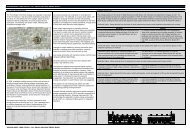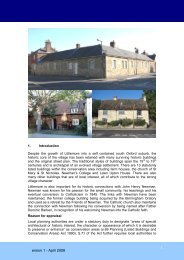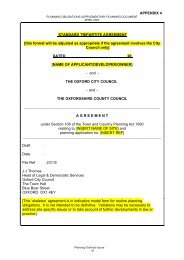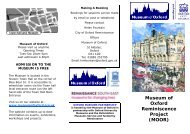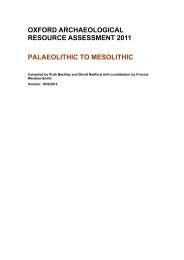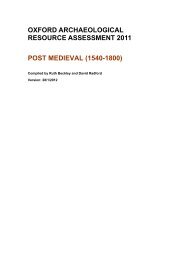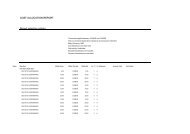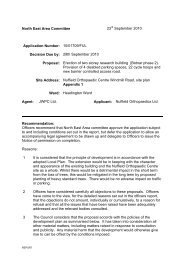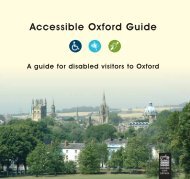item4b pt 1.pdf - Oxford City Council
item4b pt 1.pdf - Oxford City Council
item4b pt 1.pdf - Oxford City Council
You also want an ePaper? Increase the reach of your titles
YUMPU automatically turns print PDFs into web optimized ePapers that Google loves.
Site size:<br />
4. The first argument submitted by the applicant’s agent as to why no<br />
provision for affordable housing should be made relates to the site area.<br />
5. The gross area of the site, as defined by the red line boundary on the site<br />
plan submitted with the application is 0.31ha. The applicant’s agent<br />
argues that the wooded area is undevelopable and should therefore be<br />
excluded from the calculation of the site area. The applicant’s agent<br />
considers this to result in a developable area of 0.21ha which is below the<br />
threshold for requiring affordable housing under Policy HS.4 of the<br />
ado<strong>pt</strong>ed <strong>Oxford</strong> Local Plan 2001-2016.<br />
6. Whilst the Officer’s main report presented to committee on this application<br />
(dated 15 th February 2006) states at paragraph 13 that the applicant’s<br />
agent’s argument is reasonable in the light of an appeal decision in<br />
Broadland District <strong>Council</strong>, that appeal decision and this current<br />
application at St Ebba’s are not identical and it is considered that the<br />
issues should be discussed further.<br />
7. The wooded area in the Broadland DC appeal site is protected by a<br />
general TPO and the Inspector considered that it’s loss would be “highly<br />
detrimental to the landscape of this nationally important area”. The<br />
wooded area of the St Ebba’s sites does not have a protective designation,<br />
nor are any of the trees covered by a TPO and whilst this does not<br />
necessarily mean that the wooded area would be acce<strong>pt</strong>able for<br />
development, it would be a generalisation to presume that it was<br />
‘undevelopable’. Regardless of whether or not the woodland is considered<br />
to have value in landscape, screening or habitat terms, the fact that<br />
woodland is present, is not considered to inevitably make that area<br />
undevelopable as certainly the mere presence of trees do not<br />
automatically rendered land undevelopable.<br />
8. In the Broadland DC appeal decision, the appeal Inspector did not<br />
consider that wooded area to be part of the curtilage of the proposed<br />
dwellings and he therefore did not consider it as being part of the site area.<br />
This reduced the site area below the 1ha threshold for the provision of<br />
affordable housing in Broadland DC. However, in this case at St Ebba’s,<br />
the wooded area is considered part of the development site as it is labelled<br />
(plan no. 619.20) as amenity space for the dwellings.<br />
9. If this wooded area was not intended as amenity space for the proposed<br />
dwellings, then it would not be unreasonable to expect the owner retaining<br />
control of the wooded area to want to fence it off to prevent trespassers.<br />
This would then raise an issue of whether the proposed development at St<br />
Ebba’s would be acce<strong>pt</strong>able without the wooded area as amenity space.<br />
10. Because of the notable differences between the St Ebba’s proposal and<br />
the Broadland DC appeal site, the wooded area at St Ebba’s should be not<br />
REPORT 2



